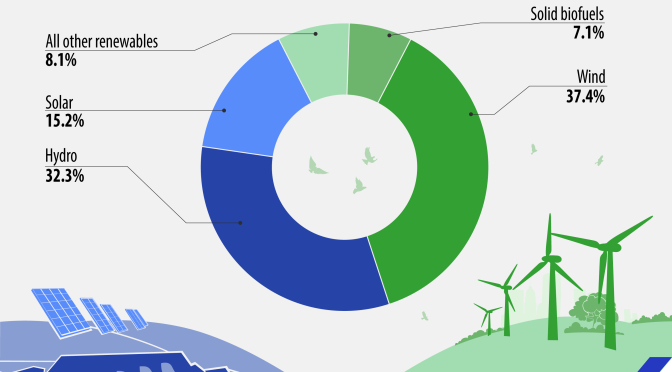Wind and solar generated a fifth (22.28%) of the EU’s electricity in 2022, surpassing gas (19.91%) for the first time in a sector dominated by nuclear and hydroelectric (32.04 %), according to data released this week by the Ember energy think tank.
“Europe has avoided the worst of the energy crisis,” summarized the head of Ember’s Data Outlook, Dave Jones, in a statement, adding that “the ‘stocks’ of 2022 only caused a small shock wave in electricity production at from coal and a huge wave of support for renewables” so “any fears of a coal rebound are now dead.”
Despite the fact that the energy crisis revitalized generation with coal, the increase in this fossil fuel to produce electricity was only 1.5 points compared to the previous year, up to 15.99% of the electricity in the community block and with a tendency to be reduced by 6% in the last four months of 2022.
In fact, the 26 coal-fired power plants placed on standby have operated at an average of 18% of their capacity and only a third of the additional 22 million tonnes of coal imported into the EU last year was used.
Despite everything, carbon dioxide emissions from electricity generation in the EU increased by 3.9% (26 million tonnes CO2), with the largest absolute increases recorded in Germany (13 MtCO2, +6.1%). , Spain (7.6 MtCO2, +19%), Italy (6.9 MtCO2, +9.3%) and Bulgaria (4.7 MtCO2, +23%) but a decrease in Poland, the second largest emitter in the EU ( -3.7 MtCO2, -2.9%).
RECORD RENEWABLES
Solar generation advanced 24% in 2022 and wind power 33% in the EU as a whole and led to savings of “10,000 million euros” in gas, according to Ember.
Twenty of the twenty-seven Member States broke their own records, Spain among them, thanks to political management but also to the citizens who installed solar panels on their roofs.
The country that generated the highest proportion of its electricity from the sun in 2022 was the Netherlands (14%), which snatched its traditional leadership from Spain (12%). Spain was in the leading block in new installed power (+21%), but the Netherlands doubled that rate (51%).
Electricity demand also fell by 7% compared to 2021 in the year as a whole and by 8.5% in the last quarter of a year in which the EU faced a “triple” crisis in the sector: sharp drop in Russian gas supplies and historically low levels of nuclear (paralysis of part of the French atomic park) and hydraulics (meteorology).
The nuclear strike in France, which in 2022 went from being an exporter to a net importer of electricity with Germany, Spain and the United Kingdom, shows “how important interconnections are to achieve security of supply.”
This circumstance also explains, according to Ember, the rise in demand for gas to generate electricity in Spain (22%) and France (29%), which “probably would not have increased without the large losses of nuclear energy in France that resulted in lower exports to Spain».
The electricity sectors of both countries also suffered the impact of the worst drought recorded in 500 years in Europe, which reduced hydroelectric generation by 23% in France and 37% in Spain.
In the EU as a whole, generation from gas increased by 0.8% and from fossil fuels in general by 3%.
According to the think tank, generation with fossil fuels “could plummet 20% in 2023” and “with the right support, solar energy will break more records”, predicted the CEO of the community employers’ association Solar Power Europe, Walburga Hemetsberger. .
Ember projects that coal will lose weight and that gas, which is expected to be more expensive than coal “through at least 2025”, will fall even more strongly as a result of the rebound in the wind and solar industry and thanks to the recovery of the hydroelectric and French nuclear.
“She shows that reducing demand, coupled with a significant increase in wind and solar generation, can replace fossil fuels in the electricity sector. It shouldn’t take a gas crisis to understand and act accordingly,” said Elif Gündüzyeli, energy policy coordinator for the Climate Action Network.
The head of the WindEurope wind energy association, Giles Dickson, welcomed the data, but pointed out that “much more is needed to meet” the renewable energy targets and called for an industrial policy based on clean energy and to “correctly” redesign the electricity market.


